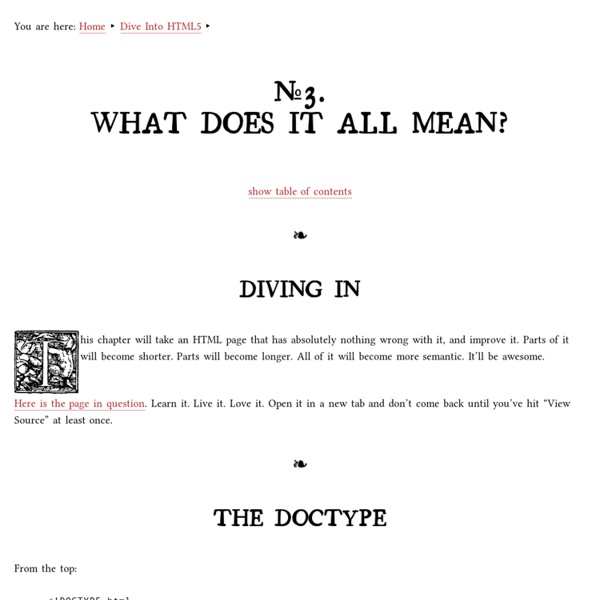Web Forms
You are here: Home Dive Into HTML5 Diving In Everybody knows about web forms, right? Make a <form>, a few <input type="text"> elements, maybe an <input type="password">, finish it off with an <input type="submit"> button, and you’re done. You don’t know the half of it. Placeholder Text The first improvement HTML5 brings to web forms is the ability to set placeholder text in an input field. You’ve probably seen placeholder text before. When you click on (or tab to) the location bar, the placeholder text disappears: Here’s how you can include placeholder text in your own web forms: Browsers that don’t support the placeholder attribute will simply ignore it. Ask Professor Markup Q: Can I use HTML markup in the placeholder attribute? Autofocus Fields Web sites can use JavaScript to focus the first input field of a web form automatically. To solve this problem, HTML5 introduces an autofocus attribute on all web form controls. Here’s how you can set a form field to autofocus: What’s that? To sum up:
Local Fresh Food and produce from KENT UK Garden of England and Farmers Markets, Kentish Fare and Food Hygiene
Writing your first Django app, part 4
This tutorial begins where Tutorial 3 left off. We’re continuing the Web-poll application and will focus on simple form processing and cutting down our code. Write a simple form Let’s update our poll detail template (“polls/detail.html”) from the last tutorial, so that the template contains an HTML <form> element: polls/templates/polls/detail.html A quick rundown: Now, let’s create a Django view that handles the submitted data and does something with it. polls/urls.py url(r'^(? We also created a dummy implementation of the vote() function. polls/views.py This code includes a few things we haven’t covered yet in this tutorial: request.POST is a dictionary-like object that lets you access submitted data by key name. As mentioned in Tutorial 3, request is a HttpRequest object. After somebody votes in a question, the vote() view redirects to the results page for the question. This is almost exactly the same as the detail() view from Tutorial 3. Now, create a polls/results.html template: Amend views
Main Page - Gupta Team Developer Tips & Tricks
An ultimate HTML5 cheatsheet you must have
Like a lot of other web developers, I am also going to start learning HTML5. It’s time to get maximum benefit of HTML5 based browsers for our websites. Here I want to share a very useful cheatsheet on HTML5. Update I have converted this cheat sheet into text form.
EMS USB2 Download Section
EMS USB2 Download Section EMS USB2 Joypad for Intel Mac 9 Oct, 06 (XP) It is the windows XP driver for Intel Mac. This software is a beta version. EMS USB2 Joypad for Mac 18 Jan, 06 (Mac OS 10.3, 10.4) It is the driver for Mac OS 10.3 and 10.4. 5 Jan, 07 (windows 7 / vista, 32bit only) This driver is designed to support 32bit Windows Vista. 22 Aug, 06 (98/ME/2K/XP) This driver is designed for our product - EMS USB2. EMS USB2 Joypad V2.71 16 Nov,05 (XP64) It is the XP 64bit version of the driver v2.7, which supports Windows XP64 only. EMS USB2 Joypad V2.66 2 Aug,05 (XP64) It is the XP 64bit version of the driver v2.65, which supports Windows XP64 only. This driver is designed for our product - EMS USB2. EMS USB2 Joypad V2.61 27 July,05 (XP64) It is the XP 64bit version of the driver v2.6, which supports Windows XP64 only. This driver is designed for our product - EMS USB2. EMS USB2 Joypad V2.51 24 July,05 (XP64) This driver is designed for our product - EMS USB2. Back to download page
Django Packages : django reusable apps, sites and tools directory
TypeWith.me: Live Text Document Collaboration!
Serving Static Content With Django
A question that is frequently asked by new Django programmers is: "How can I serve static content (css, images, javascript) with the Django development server?". This article is my attempt to answer that question by demonstrating the best practices way to do so. Why Doesn't Django Serve Static Content Automatically? Well, Django (and python in general) is built around the idea that it is better to be explicit than implicit. This means that Django doesn't force us to put all of static content into a single, specific folder or tree, we can set it up however we like. This flexibility is what Django provides for us at the cost of not being able to automatically detect / serve our static content--which is why you are reading this article :) Where Should I Put My Static Content? In general, the convention I like to use is to put all static content in my project directory underneath the 'static' folder. Which allows me to have a good looking URL schema for my projects. Configure Your Settings



